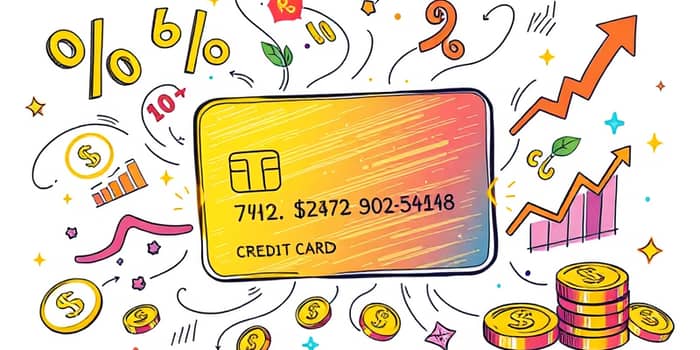Credit card APR can feel like a maze of numbers and percentages. Yet, with clear information and practical guidance, anyone can navigate these waters confidently. This article unpacks every facet of APR, illustrating how it works, why it matters, and how you can manage it effectively.
Definition and Purpose of APR
The term Annual Percentage Rate (APR) is far more than a marketing buzzword. It represents the yearly cost of borrowing on your credit card, combining the interest rate with certain fees to give a consistent comparison metric. Under the Truth in Lending Act, lenders must disclose APRs, ensuring consumers can compare offers on an even playing field.
Understanding APR starts with recognizing its role: it tells you what you’ll pay if you carry a balance across billing cycles. Though it generally excludes compounding within the year, it remains a critical measure of borrowing costs.
How APR Works
Every time you swipe your card or make an online payment, you’re potentially incurring interest—unless you pay the statement balance in full. APR quantifies this cost on a yearly basis, but calculations are usually broken down into daily or monthly rates.
It’s important not to confuse APR with APY. While APR expresses the cost, APY accounts for compounding interest over time, showing your effective yield if you were earning rather than paying interest.
Types of Credit Card APRs
Credit cards often come with multiple APRs, each tied to different transactions. Knowing these variations helps you strategize usage and avoid surprise charges.
- Purchase APR: Applied to everyday purchases on your card.
- Cash Advance APR: Charged for ATM withdrawals or cash-like transactions; usually higher.
- Balance Transfer APR: Rate on amounts shifted from another card; may include an introductory period.
- Penalty APR: A steep rate triggered by missed payments or policy violations.
- Promotional/Introductory APR: Often 0% for a set period, typically 6–21 months.
Calculating Your APR Charges
Lenders compute interest by converting the APR into a daily or monthly periodic rate. The formulas are straightforward in principle:
Daily Rate Calculation: Divide the APR by 365. For example, 20% APR translates to a daily rate of approximately 0.0548%.
Interest Charge (per cycle): Multiply the daily rate by the average daily balance and by the number of days in the billing cycle. For instance, a 22% APR gives a daily rate of 0.0006. With a $100 balance over 28 days: 0.0006 × 100 × 28 = $1.68.
Some issuers prefer a monthly periodic rate—APR divided by 12—then multiply by your balance. A 17.99% APR equals a 1.499% monthly rate, leading to a $7.50 charge on a $500 balance.
Factors That Impact Your APR
Several forces determine the APR you receive and how it may shift over time:
- Economic factors: The prime rate, Federal Reserve decisions, and inflation influence variable APRs.
- Personal factors: Your credit score, history, and payment track record shape your risk profile.
- Market factors: Lender risk tolerance, overall default rates, and subprime lending trends affect national averages.
Typical APR Ranges and What Is ‘Good’
In the early to mid-2020s, average credit card APRs generally fall between 16% and 25%. However, what constitutes a “good” APR depends on your credit profile:
- Excellent credit (740+): 13%–18%
- Good credit (670–739): 18%–23%
- Fair/poor credit (<670): 20% and above
Promotional APRs can drop to 0% for limited periods, offering relief on new purchases or transferred balances. Yet, once the intro period ends, the regular APR applies.
APR Comparison Table
How to Avoid or Reduce APR Charges
The most effective strategy is simple: pay your statement balance in full every month. By doing so, you usually benefit from a grace period and avoid purchase APR entirely.
Making at least the minimum payment prevents penalty APRs, though you’ll still incur interest on any unpaid balance. Improving your credit score over time can open doors to cards with lower APRs and better terms.
When shopping for a new card, review the cardholder agreement and monthly statements closely. Don’t focus solely on APR—consider fees, rewards, and additional benefits that impact your overall cost.
APR vs APY and Other Considerations
Remember that APR and APY serve different purposes. APR informs you of borrowing costs, whereas APY illustrates earnings on deposits or investments, factoring in compounding effects.
Comparing credit cards requires a holistic view. Look at introductory offers, balance transfer fees, annual fees, and rewards programs in addition to APR. A card with a slightly higher APR but generous rewards may offer greater value if you manage your spending wisely.
Smart financial decisions begin with understanding the fine print. Use APR as a tool to gauge borrowing costs, but integrate it into your broader budgeting and credit-building plans.
Conclusion
Credit card APR need not be intimidating. By grasping definitions, calculation methods, and the factors that influence rates, you empower yourself to make informed choices and minimize costs.
Keep these key takeaways in mind: pay on time, monitor your balances, and seek competitive offers as your credit profile strengthens. With this knowledge, you can turn APR from a source of confusion into a guide for financial health and stability.
References
- https://www.capitalone.com/learn-grow/money-management/how-to-calculate-apr-on-credit-card/
- https://www.santanderbank.com/personal/resources/credit-card/how-credit-card-interest-works
- https://www.investopedia.com/terms/a/apr.asp
- https://www.consumerfinance.gov/about-us/blog/examining-the-factors-driving-high-credit-card-interest-rates/
- https://www.td.com/us/en/personal-banking/learning/what-is-apr-on-credit-card
- https://www.chase.com/personal/credit-cards/education/interest-apr/how-to-calculate-credit-card-apr-charges
- https://bettermoneyhabits.bankofamerica.com/en/credit/what-is-apr
- https://www.citizensbank.com/learning/what-is-apr.aspx










